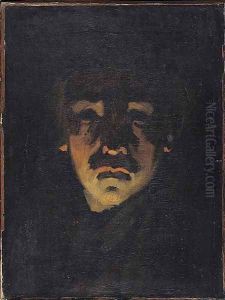Adolphe-Felix Cals Paintings
Adolphe-Felix Cals was a French painter born on October 17, 1810, in Paris. Cals began his artistic journey as an apprentice to the printmaker and lithographer, Joseph Langlumé, where he gained a strong foundation in the graphic arts. However, his aspirations led him to painting, and he later trained under the academic painter Léon Cogniet, who was well-known for his historical and portrait paintings.
Cals's early work primarily involved portraits and genre scenes, capturing the subtleties of daily life with a particular interest in the interactions between individuals. His style was deeply influenced by the Realism movement, which sought to represent subjects truthfully without artificiality and avoiding artistic conventions, implausible, exotic, and supernatural elements. Realism was a reaction to the dramatic and emotive styles of Romanticism that preceded it.
Despite the prevailing tastes of the time, which favored grand historical and mythological scenes, Cals's work stood out through his focus on the ordinary and the everyday. He exhibited at the Paris Salon, the official art exhibition of the Académie des Beaux-Arts in Paris, from the 1830s onwards. However, he did not gain significant recognition until much later in his career.
A turning point in Cals's life came with his association with the Barbizon School, a group of artists who worked in the village of Barbizon near the Forest of Fontainebleau. This school was pivotal in the development of landscape painting in France, with artists like Jean-François Millet, Théodore Rousseau, and Charles-François Daubigny. Influenced by their emphasis on painting nature en plein air (outdoors), Cals began to incorporate these principles into his own work, which brought a new vitality and sense of light to his paintings.
Cals was also associated with the Impressionists, and though he never achieved the fame of contemporaries like Claude Monet or Pierre-Auguste Renoir, he participated in several of the Impressionist exhibitions. His later works are characterized by their loose brushwork and luminous palette, reflecting the evolving style of the time and his integration of Impressionist techniques.
Adolphe-Felix Cals faced financial difficulties and struggled with poor health throughout his life, but he found some solace and support in the art community. He continued to paint until his death on October 3, 1880, in Paris. Although not as well-known as some of his peers, Cals's contribution to French art, particularly his intimate portrayals of Parisian life and his transitional work between Realism and Impressionism, has earned him a respectable place in art history.










